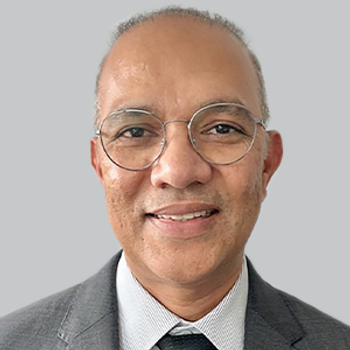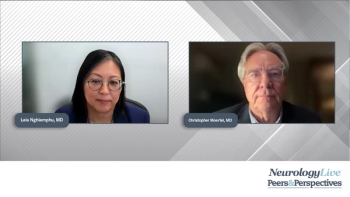
NeuroVoices: Marcus Yountz, on the Promise and Phase 2 Data of Orexin Agent Alixorexton
The VP of clinical development at Alkermes detailed phase 2 results for alixorexton, an oral, selective orexin 2 receptor agonist, in narcolepsy type 1, including benefits for fatigue, cognition, and weakness.
In recent years, interest in orexin receptor agonists has surged due to their potential to address the underlying cause of narcolepsy, orexin deficiency, rather than merely easing symptoms. Among them is alixorexton (Alkermes), formerly referred to as ALKS 2680, which is being studied as a once-daily treatment for narcolepsy type 1 (NT1), narcolepsy type 2 (NT2), and idiopathic hypersomnia (IH).
At the World Sleep Congress, which took place September 5 to 10, 2025, in Singapore, Alkermes presented detailed results from its phase 2 Vibrance-1 trial (NCT06358950), testing multiple doses of the agent in 92 patients with NT1. The dose-finding, placebo-controlled trial used change in wakefulness, assessed through the Maintenance of Wakefulness Test (MWT) after 6 weeks, as the primary end point. Other secondary end points included change in Epworth Sleepiness Scale score, mean weekly cataplexy rate, and incidence of adverse events.
As part of a new iteration of NeuroVoices, NeurologyLive® sat down with Marcus Yountz, MD, FAAN, vice president of clinical development at Alkermes, to discuss the results in greater detail. He spoke about the therapy’s mechanism and potential beyond NT1 and gave an overview of Vibrance-1 and some promising early data on wakefulness, cataplexy, and sleepiness. Importantly, he emphasized exploratory outcomes showing benefits for fatigue and cognition, 2 often overlooked but highly impactful symptoms in narcolepsy, which broaden the understanding of treatment success and will guide Alkermes’ upcoming phase 3 program.
NeurologyLive: Can you provide context on alixorexton, its mechanism, and why it may work across multiple sleep disorders?
Marcus Yountz, MD, FAAN: Alixorexton, formerly known as ALKS 2680, is an orexin 2 receptor agonist. What that means is it’s designed to mimic the natural activity of the orexin neuropeptide. Orexin signaling is critical for maintaining wakefulness and regulating sleep, and when you don’t have it—or you don’t have enough of it—you see very distinct disorders.
In narcolepsy type 1, the most obvious application, patients have either a dramatic loss or even complete absence of orexin-producing neurons. That’s what makes NT1 such a clear target because you’re essentially replacing a missing signal. By directly stimulating the orexin 2 receptor, alixorexton can provide the activity that those patients are lacking.
Beyond NT1, though, there’s evidence that orexin signaling plays a role in other hypersomnolence disorders like narcolepsy type 2 and idiopathic hypersomnia. Those aren’t caused by the same loss of neurons, but orexin still regulates circuits across the brain that are involved in alertness, cognition, and fatigue. Because the system is so broadly distributed, we believe this therapy has the potential to impact multiple sleep disorders, not just NT1. That’s why we’re studying it across the spectrum.
Do you have any timelines for Vibrance-2 and Vibrance-3?
For Vibrance-2, the trial in narcolepsy type 2, we’re anticipating top-line results this fall. I don’t have a more precise date than that, but sometime in the fall, we expect to be able to share data.
Vibrance-3, which is our trial in idiopathic hypersomnia, started later and is still actively enrolling. That study is going well, and based on enrollment progress, we expect results in the first half of next year. Between now and mid–next year, we’ll have data across all 3 of these sleep disorders.
Can you provide an overview of Vibrance-1 and the main efficacy and safety findings?
Vibrance-1 was our study in narcolepsy type 1. It was designed as a hybrid trial: a 6-week randomized, double-blind, placebo-controlled phase followed by a 7-week optional open-label extension. Patients could be in the study for up to 13 weeks overall.
Patients were randomly assigned to 1 of 3 fixed doses of alixorexton—4 mg, 6 mg, or 8 mg—or to placebo during the double-blind portion. After 6 weeks, those who entered the open-label extension all switched to alixorexton starting at 6 mg. The transfer from placebo to active drug was blinded, so patients didn’t know what they had received in the first phase. In the extension, there was a 2-week period when patients and their physicians could adjust the dose up or down, and then they remained stable for the final 5 weeks. That design gave us a chance to see both fixed-dose effects and what happens when you allow some real-world style titration.
The primary end point was mean sleep latency on the MWT, which is a standard objective measure of the ability to stay awake. Key secondary end points included the Epworth Sleepiness Scale and the frequency of cataplexy attacks. Across these measures, we saw meaningful improvements with alixorexton compared with placebo.
From a safety standpoint, the drug was well tolerated. There were no unexpected safety signals and no discontinuations due to adverse events in the trial. That was encouraging, particularly given that we were testing 3 different doses.
What insights did you gain from exploratory measures such as fatigue and cognition?
Yountz: This was one of the most exciting parts of the trial. Fatigue and cognition aren’t always captured in sleep disorder trials, but when you talk to patients, they consistently raise these issues.
Fatigue is distinct from sleepiness. Sleepiness is that physiological drive to fall asleep. You feel your eyes closing; you drift off. Fatigue is a broader sense of exhaustion, both physical and mental. Patients often describe it as being drained even if they’ve been able to stay awake. More than half of people with narcolepsy report significant fatigue, and it can be just as debilitating as the sleepiness itself.
In Vibrance-1, we used the PROMIS [Patient-Reported Outcomes Measurement Information System] Fatigue Scale, which is validated across many disease states, as well as the Patient Global Impression of Fatigue Severity. On both measures, across all dose groups, we saw clinically meaningful, statistically significant improvements. Moving the needle on fatigue is hard in trials, so seeing that consistent effect gave us a lot of confidence.
Cognition was another area we explored. Patients often describe “brain fog”—trouble focusing, memory lapses, difficulty finding words. We used the British Columbia Cognitive Complaints Inventory and asked patients directly how they perceived their cognition. On both measures, we saw improvements that were not only statistically significant but also clinically meaningful. Importantly, the 2 measures complemented each other: What patients reported lined up with what the structured inventory showed. That alignment strengthens the finding.
When you step back, you see improvements in the core outcomes—MWT, Epworth, cataplexy—and then on top of that, gains in areas like fatigue and cognition that really matter for daily life.
How do these exploratory outcomes inform the bigger picture for patients?
They help broaden the view of what treatment success looks like. It’s not just about whether someone can stay awake a little longer in a lab setting, although that’s important. It’s also about whether they feel less exhausted during the day, whether they can concentrate better, whether they’re able to engage more fully in work, school, or family life.
Seeing consistent improvements across multiple exploratory end points tells us that alixorexton isn’t just addressing 1 symptom; it also may be improving the overall disease burden. For patients, that’s incredibly meaningful.
Can you comment on plans for phase 3 development?
As you’d expect, we are actively planning our phase 3 program now. Much of the design will be based on what we’ve learned from Vibrance-1 and from our earlier phase 1b study. We’re looking at which end points are most sensitive, which doses are optimal, and how best to design a trial that can support regulatory approval.
I can’t share specific details yet, but I can say the program will cover NT1, NT2, and idiopathic hypersomnia. Our goal is to advance efficiently to pivotal studies that will give us the evidence we need. We’ll be sharing more as those plans solidify, but the takeaway is that we’re moving forward with real momentum.
Transcript edited for clarity.
Newsletter
Keep your finger on the pulse of neurology—subscribe to NeurologyLive for expert interviews, new data, and breakthrough treatment updates.































